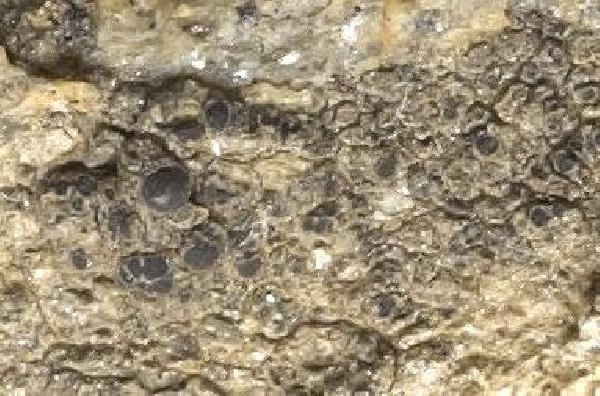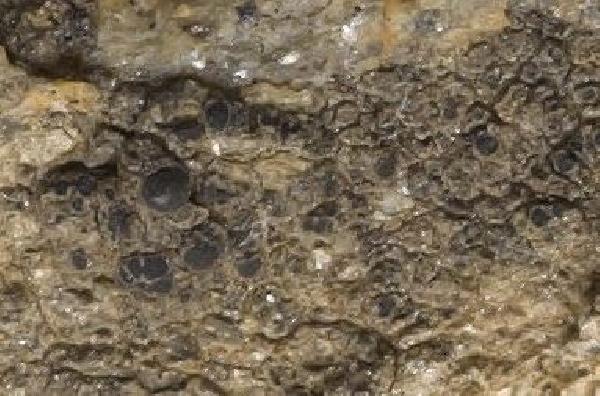Rinodina venostana Buschardt & H. Mayrhofer
in Mayrhofer & Poelt, Bibl. Lichenol., 12: 155, 1979.
Synonyms: Rinodina exigua f. saxicola Anzi
Description: Thallus crustose, episubstratic, pale grey to grey, rimose-areolate to verrucose, most often almost completely covered with apothecia, without a distinct prothallus. Apothecia lecanorine to cryptolecanorine, crowded, slightly immersed in thallus to sessile, up to 0.5 mm across, with a black, more or less flat disc, and an entire thalline margin. Epithecium brown, K-; hymenium colourless, 80-100 µm high; paraphyses branched in upper part, c. 1.5 µm thick at mid-level, the apical cells capitate, 3-5 µm wide; hypothecium colourless, up to 150 µm high. Asci 8-spored, broadly clavate, the K/I+ blue tholus penetrated by a faintly amyloid apical cushion with parallel or diverging flanks, the wall K/I-, surrounded by a K/I+ blue outer layer, Lecanora-type. Ascospores 1-septate, brown, ellipsoid, 15-20 x 7-11 µm, Physcia-type, with a well-developed, often tripartite torus and ontogeny of type A (apical wall thickening after septum formation). Photobiont chlorococcoid. Spot tests: K-, C-, KC-, P-, UV-. Chemistry: apparently without lichen substances.
Growth form: Crustose
Substrata: rocks
Photobiont: green algae other than Trentepohlia
Reproductive strategy: mainly sexual
Subcontinental: restricted to areas with a dry-subcontinental climate (e.g. dry Alpine valleys, parts of Mediterranean Italy)
Commonnes-rarity: (info)
Alpine belt: absent
Subalpine belt: absent
Montane belt: rare
Dry submediterranean belt: very rare
Humid submediterranean belt: absent
Padanian area: absent
pH of the substrata:
1 2 3 4 5
Solar irradiation:
1 2 3 4 5
Aridity:
1 2 3 4 5
Eutrophication:
1 2 3 4 5
Poleotolerance:
0 1 2 3
Altitudinal distribution:
1 2 3 4 5 6
Rarity
absent
extremely rare
very rare
rare
rather rare
rather common
common
very common
extremely common
Loading data...
Occurrence data
Predictive map
Growth form: Crustose
Substrata: rocks
Photobiont: green algae other than Trentepohlia
Reproductive strategy: mainly sexual
Subcontinental: restricted to areas with a dry-subcontinental climate (e.g. dry Alpine valleys, parts of Mediterranean Italy)
Commonnes-rarity: (info)
Alpine belt: absent
Subalpine belt: absent
Montane belt: rare
Dry submediterranean belt: very rare
Humid submediterranean belt: absent
Padanian area: absent
pH of the substrata:
| 1 | 2 | 3 | 4 | 5 |
Solar irradiation:
| 1 | 2 | 3 | 4 | 5 |
Aridity:
| 1 | 2 | 3 | 4 | 5 |
Eutrophication:
| 1 | 2 | 3 | 4 | 5 |
Poleotolerance:
| 0 | 1 | 2 | 3 |
Altitudinal distribution:
| 1 | 2 | 3 | 4 | 5 | 6 |
Rarity
absent
extremely rare
very rare
rare
rather rare
rather common
common
very common
extremely common
Loading data...
Occurrence data
Predictive map








